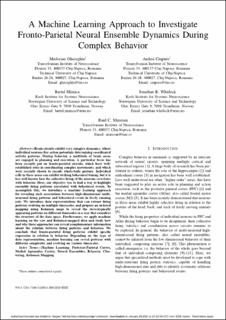| dc.contributor.author | Gheorghiu, Medorian | |
| dc.contributor.author | Ciuparu, Andrei | |
| dc.contributor.author | Mimica, Bartul | |
| dc.contributor.author | Whitlock, Jonathan | |
| dc.contributor.author | Mureşan, Raul | |
| dc.date.accessioned | 2021-02-23T08:57:54Z | |
| dc.date.available | 2021-02-23T08:57:54Z | |
| dc.date.created | 2021-01-29T16:08:48Z | |
| dc.date.issued | 2020 | |
| dc.identifier.isbn | 978-1-7281-7167-8 | |
| dc.identifier.uri | https://hdl.handle.net/11250/2729667 | |
| dc.description.abstract | Brain circuits exhibit very complex dynamics, where individual neurons fire action potentials determining coordinated activity patterns. During behavior, a multitude of brain areas are engaged in planning and execution. A particular focus has been recently put on fronto-parietal circuits, which have well-established roles in coordinating complex movements, and which were recently shown to encode whole-body posture. Individual cells in these areas can exhibit striking behavioral tuning, but it is less well known how the collective firing of the neurons correlates with behavior. Here, our objective was to find a way to highlight ensemble firing patterns correlated with behavioral events. To accomplish this, we introduce a machine learning approach for revealing such associations between high-dimensional multi-neuronal firing patterns and behavioral events in freely running rats. We introduce data representations that can extract firing patterns evolving on multiple timescales, and propose an ordered mapping using Kohonen maps to reveal the stereotypically appearing patterns on different timescales in a way that considers the structure of the data space. Furthermore, we apply machine learning on the raw and Kohonen-mapped data and study how and why these approaches can reveal complementary information about the relation between firing patterns and behavior. We conclude that fronto-parietal firing patterns exhibit specific expression in relation to behavior. Depending on the type of data representation, machine learning can reveal patterns with different complexity and evolving on various timescales. | en_US |
| dc.language.iso | eng | en_US |
| dc.publisher | Institute of Electrical and Electronics Engineers (IEEE) | en_US |
| dc.relation.ispartof | A Machine Learning Approach to Investigate Fronto-Parietal Neural Ensemble Dynamics During Complex Behavior | |
| dc.relation.uri | 10.1109/AQTR49680.2020.9129986 | |
| dc.title | A Machine Learning Approach to Investigate Fronto-Parietal Neural Ensemble Dynamics During Complex | en_US |
| dc.type | Chapter | en_US |
| dc.description.version | acceptedVersion | en_US |
| dc.subject.nsi | VDP::Matematikk og naturvitenskap: 400 | en_US |
| dc.subject.nsi | VDP::Mathematics and natural scienses: 400 | en_US |
| dc.identifier.doi | 10.1109/AQTR49680.2020.9129986 | |
| dc.identifier.cristin | 1882802 | |
| dc.relation.project | EC/FP7/335328 | en_US |
| dc.description.localcode | © 2020 IEEE. Personal use of this material is permitted. Permission from IEEE must be obtained for all other uses, in any current or future media, including reprinting/republishing this material for advertising or promotional purposes, creating new collective works, for resale or redistribution to servers or lists, or reuse of any copyrighted component of this work in other works. | en_US |
| cristin.ispublished | true | |
| cristin.fulltext | postprint | |
| cristin.qualitycode | 1 | |
